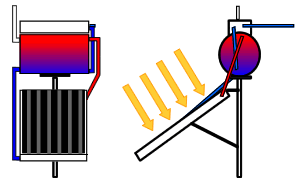The Solar House has a solar water heater on the roof for the bathroom shower and kitchen tap, and a system of external solar heating for demonstration (Figure 1). The external installation of these systems is not very common but it is an alternative for situations where local conditions are not suitable.

Figure 1 - External solar heating system
Solar thermal energy, i.e., using the sun's energy to heat water is becoming increasingly frequent. The solar heating system is basically composed by a flat solar collector and a heat reservoir.
The solar collector is responsible for absorption of solar radiation and for transferring the work fluid (usually water) in the form of thermal energy. The flat solar collectors, used for water heating, can be classified into two groups: closed and open.
Closed collectors are used to promote water heating to temperatures up to 70 oC; open collectors are recommended for heating pools that operate at low temperature, between 28 and 30 0C.
The flat solar collector consists of a metal housing made of aluminium which has therein an absorber plate painted black and copper tubes, through which the water to be heated flows. In front of the collector there is a transparent glass cover. The whole system is thermally insulated to prevent heat loss to the environment. The system has a good seal to keep it free from external moisture. Figure 2 illustrates the operating principle of the solar water heating system in the area, where the area in red represents warmer water that has been heated by solar radiation in the plane collector in comparison to the area in blue.

Figure 2 - Operation of the solar heating system.
The heat reservoir is a tank for storing hot water coming from the solar collector to meet the daily demand, even outside the hours of solar incidence. It comprises a cylindrical inner body, usually made of stainless steel or copper, and it is thermally insulated to minimize heat loss to the environment. For external protection, it is recommended the use of metallic layers.
s the incidence of radiation is intermittent (also night shifts and periods of cloudy and rainy weather), in general the solar heating systems have a form of auxiliary heating, usually electric or gas ones.